Mixed Methods Research: Definitions, Advantages, and Current Issues
VerifiedAdded on 2020/02/03
|10
|3111
|39
Essay
AI Summary
This essay provides a comprehensive overview of mixed methods research, defining it as a research design that integrates both philosophical assumptions and methodologies. It emphasizes the collection, analysis, and mixing of quantitative and qualitative data to offer a more complete understanding of research problems than either approach alone. The essay discusses the advantages of mixed methods research, such as compensating for the weaknesses of individual methods, providing more thorough evidence, and addressing research questions unanswerable by single methodologies. It also explores the ways data can be mixed, including combining, connecting, or embedding datasets. Finally, the essay addresses current issues in mixed methods research, such as the stages of mixing, effective methods for integration, and the philosophical positions best suited to support this approach. It concludes by highlighting the value of mixed methods as a powerful third worldview in research.
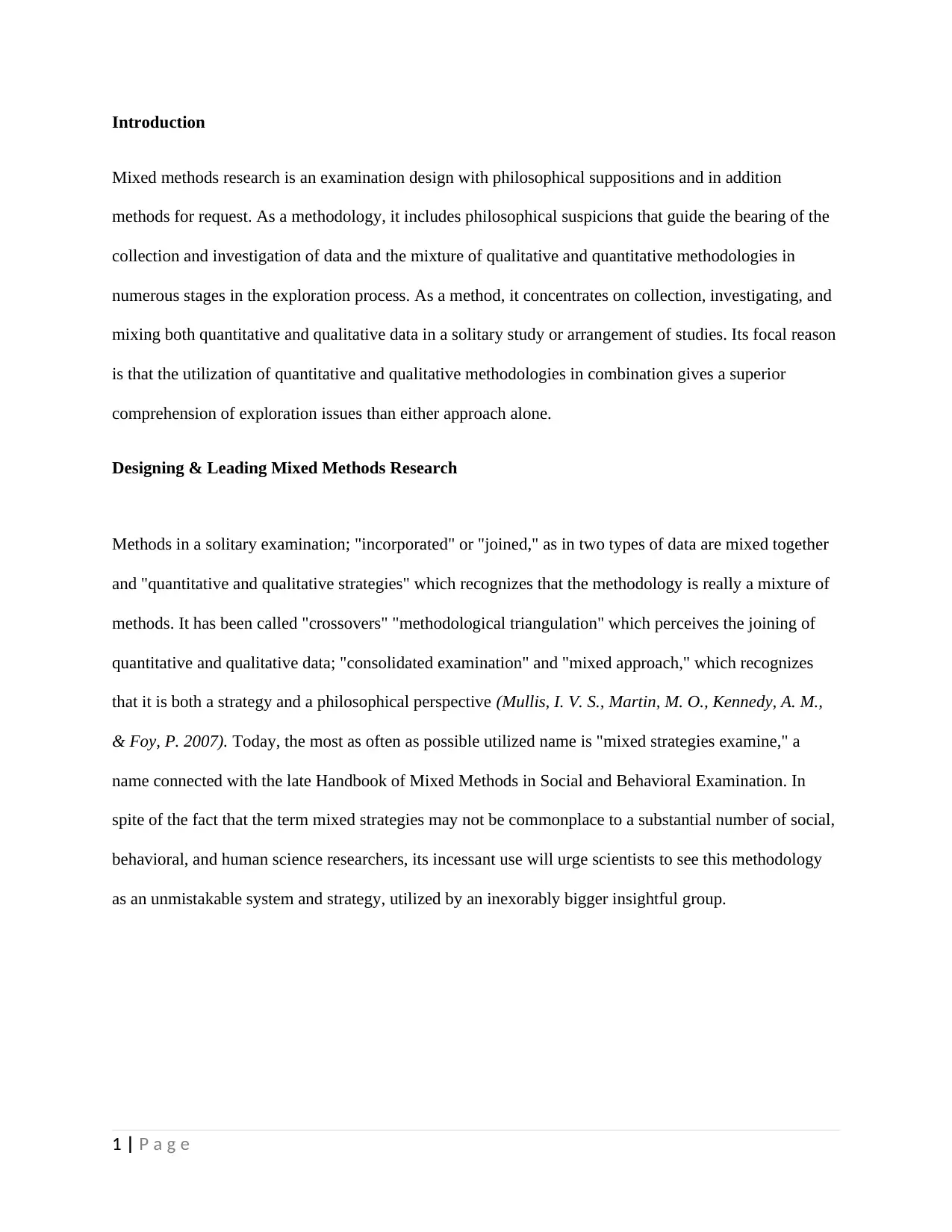
Introduction
Mixed methods research is an examination design with philosophical suppositions and in addition
methods for request. As a methodology, it includes philosophical suspicions that guide the bearing of the
collection and investigation of data and the mixture of qualitative and quantitative methodologies in
numerous stages in the exploration process. As a method, it concentrates on collection, investigating, and
mixing both quantitative and qualitative data in a solitary study or arrangement of studies. Its focal reason
is that the utilization of quantitative and qualitative methodologies in combination gives a superior
comprehension of exploration issues than either approach alone.
Designing & Leading Mixed Methods Research
Methods in a solitary examination; "incorporated" or "joined," as in two types of data are mixed together
and "quantitative and qualitative strategies" which recognizes that the methodology is really a mixture of
methods. It has been called "crossovers" "methodological triangulation" which perceives the joining of
quantitative and qualitative data; "consolidated examination" and "mixed approach," which recognizes
that it is both a strategy and a philosophical perspective (Mullis, I. V. S., Martin, M. O., Kennedy, A. M.,
& Foy, P. 2007). Today, the most as often as possible utilized name is "mixed strategies examine," a
name connected with the late Handbook of Mixed Methods in Social and Behavioral Examination. In
spite of the fact that the term mixed strategies may not be commonplace to a substantial number of social,
behavioral, and human science researchers, its incessant use will urge scientists to see this methodology
as an unmistakable system and strategy, utilized by an inexorably bigger insightful group.
1 | P a g e
Mixed methods research is an examination design with philosophical suppositions and in addition
methods for request. As a methodology, it includes philosophical suspicions that guide the bearing of the
collection and investigation of data and the mixture of qualitative and quantitative methodologies in
numerous stages in the exploration process. As a method, it concentrates on collection, investigating, and
mixing both quantitative and qualitative data in a solitary study or arrangement of studies. Its focal reason
is that the utilization of quantitative and qualitative methodologies in combination gives a superior
comprehension of exploration issues than either approach alone.
Designing & Leading Mixed Methods Research
Methods in a solitary examination; "incorporated" or "joined," as in two types of data are mixed together
and "quantitative and qualitative strategies" which recognizes that the methodology is really a mixture of
methods. It has been called "crossovers" "methodological triangulation" which perceives the joining of
quantitative and qualitative data; "consolidated examination" and "mixed approach," which recognizes
that it is both a strategy and a philosophical perspective (Mullis, I. V. S., Martin, M. O., Kennedy, A. M.,
& Foy, P. 2007). Today, the most as often as possible utilized name is "mixed strategies examine," a
name connected with the late Handbook of Mixed Methods in Social and Behavioral Examination. In
spite of the fact that the term mixed strategies may not be commonplace to a substantial number of social,
behavioral, and human science researchers, its incessant use will urge scientists to see this methodology
as an unmistakable system and strategy, utilized by an inexorably bigger insightful group.
1 | P a g e
Paraphrase This Document
Need a fresh take? Get an instant paraphrase of this document with our AI Paraphraser
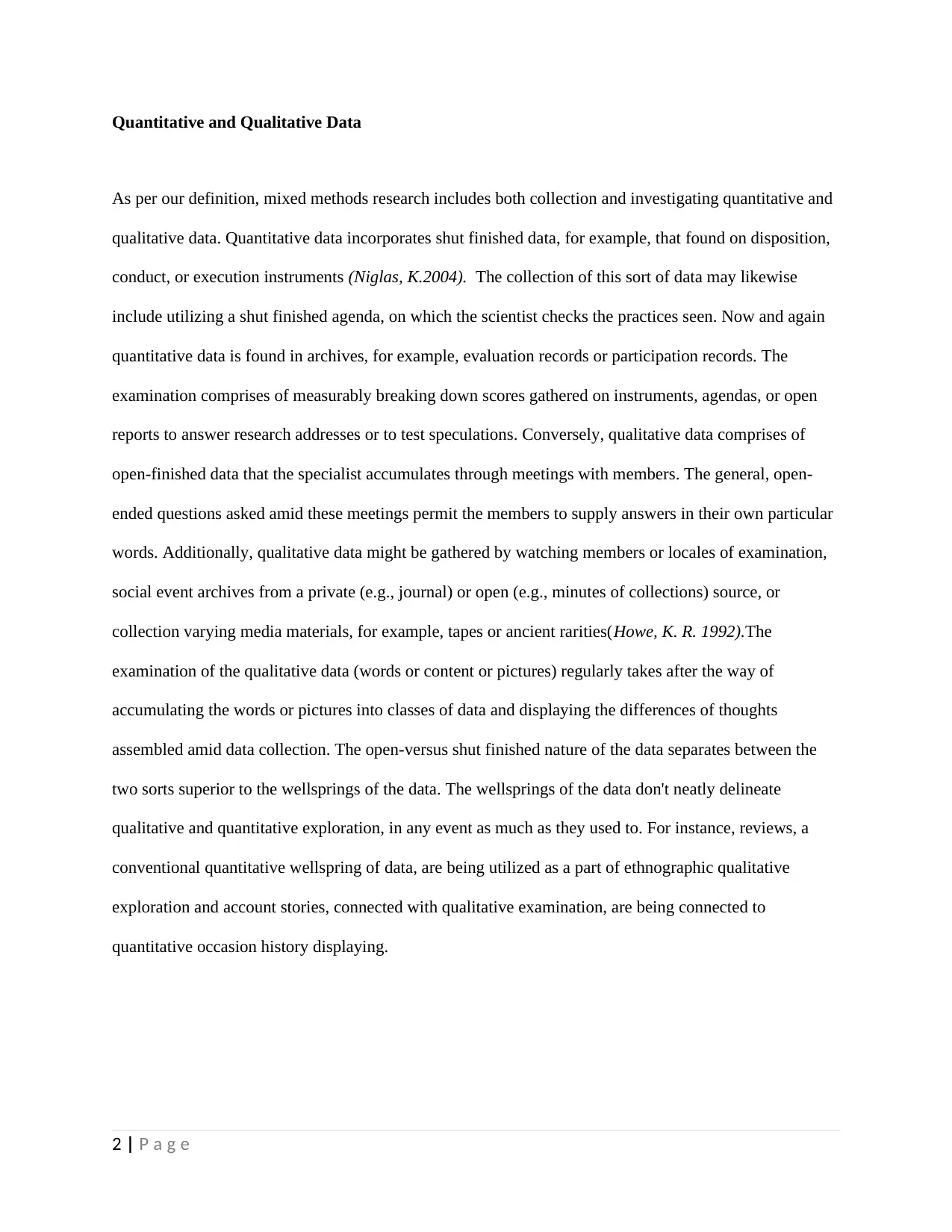
Quantitative and Qualitative Data
As per our definition, mixed methods research includes both collection and investigating quantitative and
qualitative data. Quantitative data incorporates shut finished data, for example, that found on disposition,
conduct, or execution instruments (Niglas, K.2004). The collection of this sort of data may likewise
include utilizing a shut finished agenda, on which the scientist checks the practices seen. Now and again
quantitative data is found in archives, for example, evaluation records or participation records. The
examination comprises of measurably breaking down scores gathered on instruments, agendas, or open
reports to answer research addresses or to test speculations. Conversely, qualitative data comprises of
open-finished data that the specialist accumulates through meetings with members. The general, open-
ended questions asked amid these meetings permit the members to supply answers in their own particular
words. Additionally, qualitative data might be gathered by watching members or locales of examination,
social event archives from a private (e.g., journal) or open (e.g., minutes of collections) source, or
collection varying media materials, for example, tapes or ancient rarities(Howe, K. R. 1992).The
examination of the qualitative data (words or content or pictures) regularly takes after the way of
accumulating the words or pictures into classes of data and displaying the differences of thoughts
assembled amid data collection. The open-versus shut finished nature of the data separates between the
two sorts superior to the wellsprings of the data. The wellsprings of the data don't neatly delineate
qualitative and quantitative exploration, in any event as much as they used to. For instance, reviews, a
conventional quantitative wellspring of data, are being utilized as a part of ethnographic qualitative
exploration and account stories, connected with qualitative examination, are being connected to
quantitative occasion history displaying.
2 | P a g e
As per our definition, mixed methods research includes both collection and investigating quantitative and
qualitative data. Quantitative data incorporates shut finished data, for example, that found on disposition,
conduct, or execution instruments (Niglas, K.2004). The collection of this sort of data may likewise
include utilizing a shut finished agenda, on which the scientist checks the practices seen. Now and again
quantitative data is found in archives, for example, evaluation records or participation records. The
examination comprises of measurably breaking down scores gathered on instruments, agendas, or open
reports to answer research addresses or to test speculations. Conversely, qualitative data comprises of
open-finished data that the specialist accumulates through meetings with members. The general, open-
ended questions asked amid these meetings permit the members to supply answers in their own particular
words. Additionally, qualitative data might be gathered by watching members or locales of examination,
social event archives from a private (e.g., journal) or open (e.g., minutes of collections) source, or
collection varying media materials, for example, tapes or ancient rarities(Howe, K. R. 1992).The
examination of the qualitative data (words or content or pictures) regularly takes after the way of
accumulating the words or pictures into classes of data and displaying the differences of thoughts
assembled amid data collection. The open-versus shut finished nature of the data separates between the
two sorts superior to the wellsprings of the data. The wellsprings of the data don't neatly delineate
qualitative and quantitative exploration, in any event as much as they used to. For instance, reviews, a
conventional quantitative wellspring of data, are being utilized as a part of ethnographic qualitative
exploration and account stories, connected with qualitative examination, are being connected to
quantitative occasion history displaying.
2 | P a g e
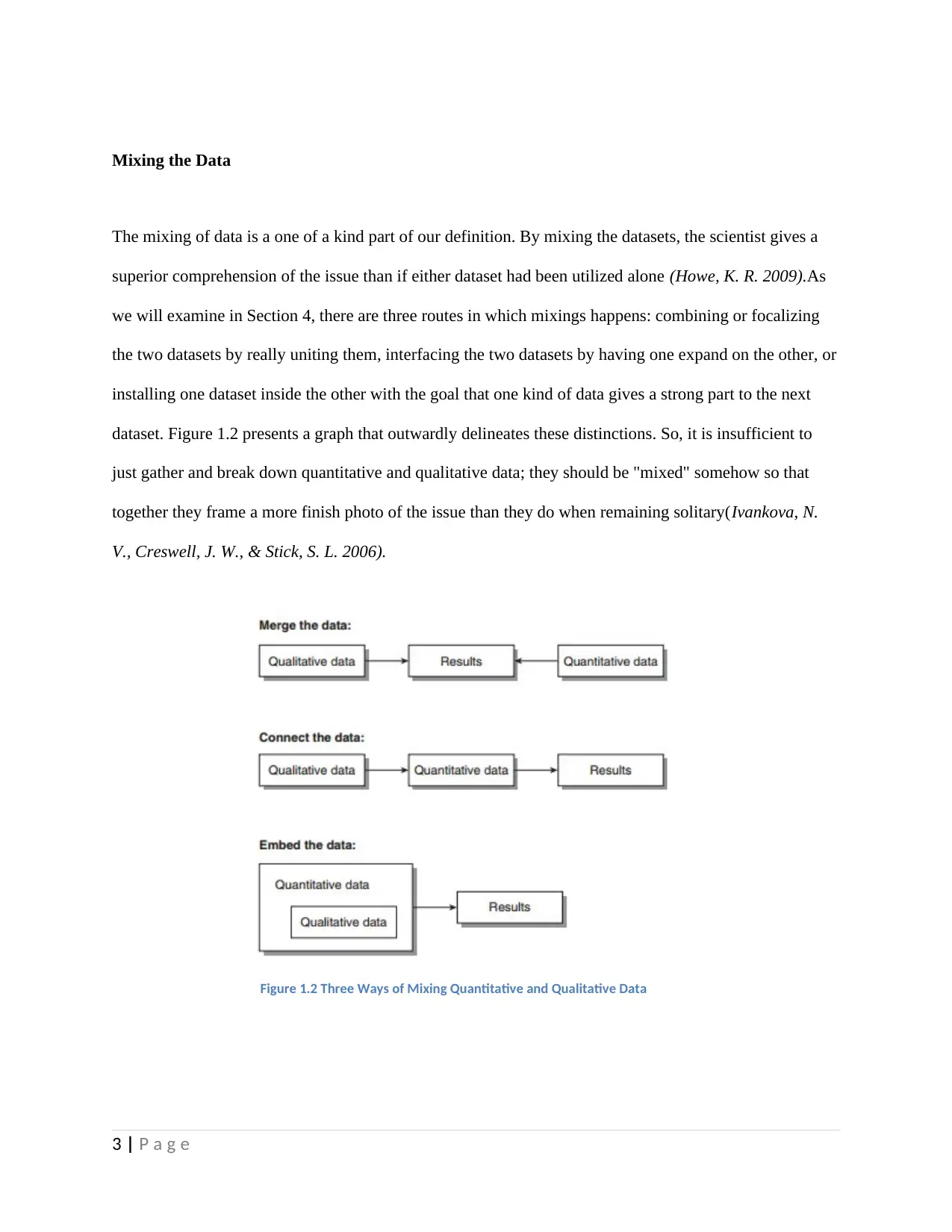
Mixing the Data
The mixing of data is a one of a kind part of our definition. By mixing the datasets, the scientist gives a
superior comprehension of the issue than if either dataset had been utilized alone (Howe, K. R. 2009).As
we will examine in Section 4, there are three routes in which mixings happens: combining or focalizing
the two datasets by really uniting them, interfacing the two datasets by having one expand on the other, or
installing one dataset inside the other with the goal that one kind of data gives a strong part to the next
dataset. Figure 1.2 presents a graph that outwardly delineates these distinctions. So, it is insufficient to
just gather and break down quantitative and qualitative data; they should be "mixed" somehow so that
together they frame a more finish photo of the issue than they do when remaining solitary(Ivankova, N.
V., Creswell, J. W., & Stick, S. L. 2006).
Figure 1.2 Three Ways of Mixing Quantitative and Qualitative Data
3 | P a g e
The mixing of data is a one of a kind part of our definition. By mixing the datasets, the scientist gives a
superior comprehension of the issue than if either dataset had been utilized alone (Howe, K. R. 2009).As
we will examine in Section 4, there are three routes in which mixings happens: combining or focalizing
the two datasets by really uniting them, interfacing the two datasets by having one expand on the other, or
installing one dataset inside the other with the goal that one kind of data gives a strong part to the next
dataset. Figure 1.2 presents a graph that outwardly delineates these distinctions. So, it is insufficient to
just gather and break down quantitative and qualitative data; they should be "mixed" somehow so that
together they frame a more finish photo of the issue than they do when remaining solitary(Ivankova, N.
V., Creswell, J. W., & Stick, S. L. 2006).
Figure 1.2 Three Ways of Mixing Quantitative and Qualitative Data
3 | P a g e
⊘ This is a preview!⊘
Do you want full access?
Subscribe today to unlock all pages.

Trusted by 1+ million students worldwide
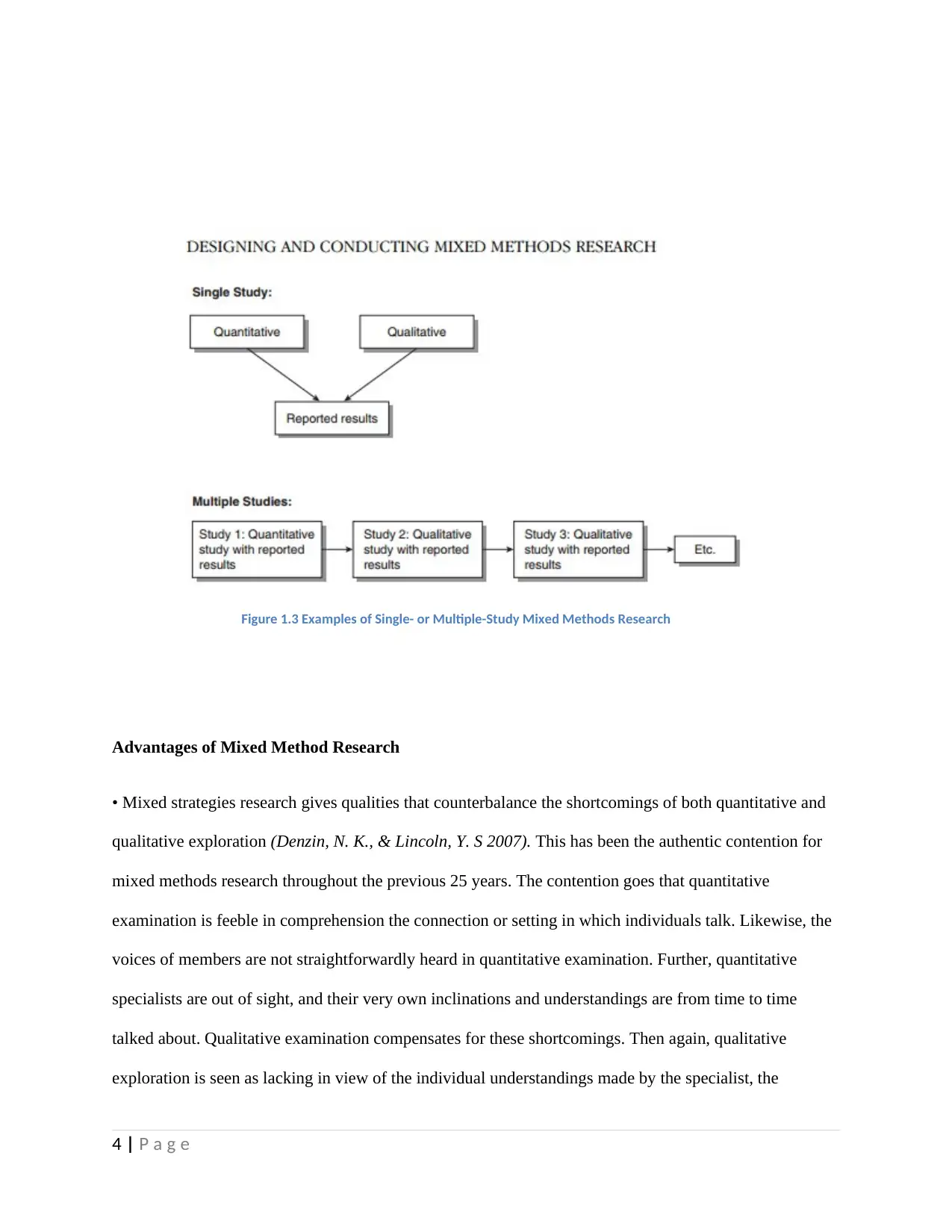
Figure 1.3 Examples of Single- or Multiple-Study Mixed Methods Research
Advantages of Mixed Method Research
• Mixed strategies research gives qualities that counterbalance the shortcomings of both quantitative and
qualitative exploration (Denzin, N. K., & Lincoln, Y. S 2007). This has been the authentic contention for
mixed methods research throughout the previous 25 years. The contention goes that quantitative
examination is feeble in comprehension the connection or setting in which individuals talk. Likewise, the
voices of members are not straightforwardly heard in quantitative examination. Further, quantitative
specialists are out of sight, and their very own inclinations and understandings are from time to time
talked about. Qualitative examination compensates for these shortcomings. Then again, qualitative
exploration is seen as lacking in view of the individual understandings made by the specialist, the
4 | P a g e
Advantages of Mixed Method Research
• Mixed strategies research gives qualities that counterbalance the shortcomings of both quantitative and
qualitative exploration (Denzin, N. K., & Lincoln, Y. S 2007). This has been the authentic contention for
mixed methods research throughout the previous 25 years. The contention goes that quantitative
examination is feeble in comprehension the connection or setting in which individuals talk. Likewise, the
voices of members are not straightforwardly heard in quantitative examination. Further, quantitative
specialists are out of sight, and their very own inclinations and understandings are from time to time
talked about. Qualitative examination compensates for these shortcomings. Then again, qualitative
exploration is seen as lacking in view of the individual understandings made by the specialist, the
4 | P a g e
Paraphrase This Document
Need a fresh take? Get an instant paraphrase of this document with our AI Paraphraser
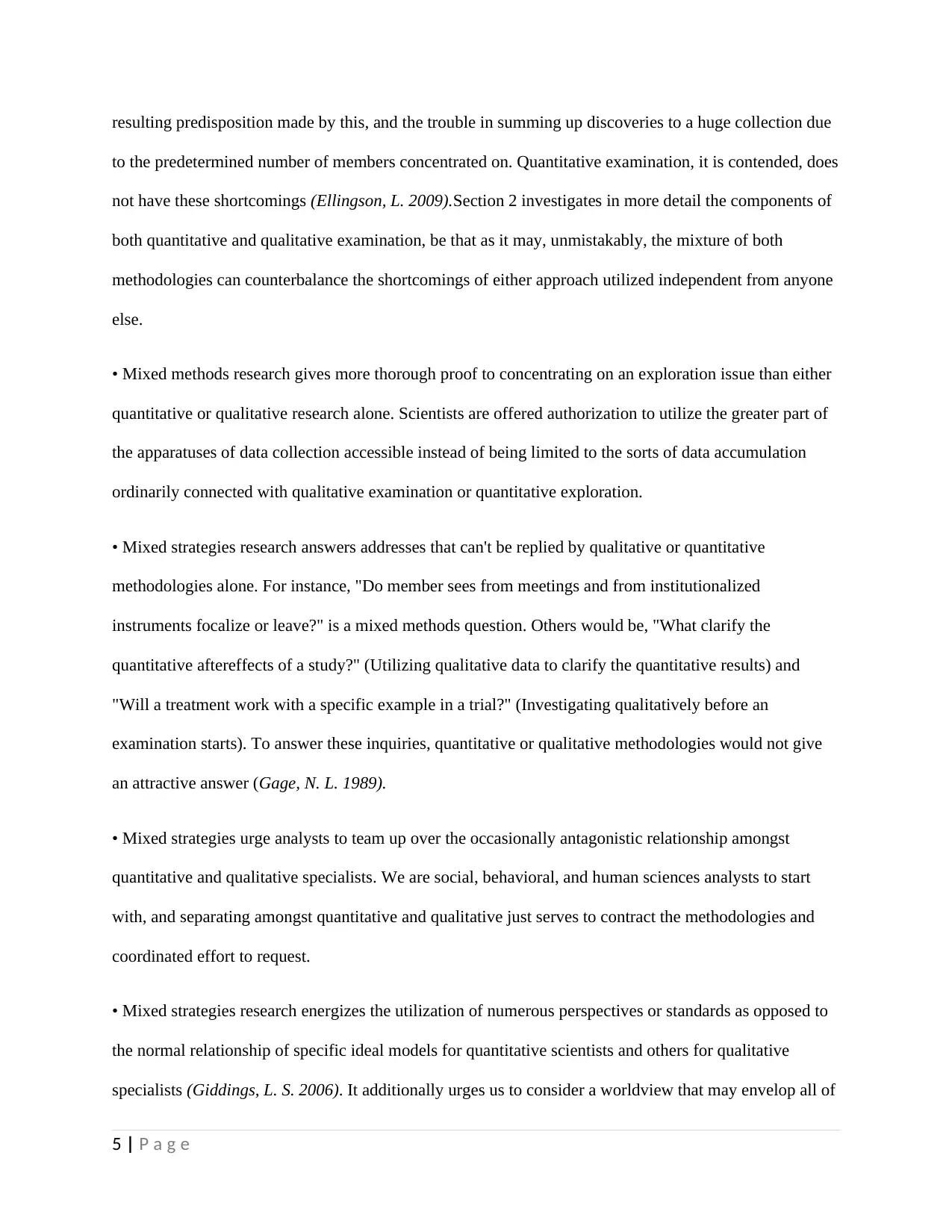
resulting predisposition made by this, and the trouble in summing up discoveries to a huge collection due
to the predetermined number of members concentrated on. Quantitative examination, it is contended, does
not have these shortcomings (Ellingson, L. 2009).Section 2 investigates in more detail the components of
both quantitative and qualitative examination, be that as it may, unmistakably, the mixture of both
methodologies can counterbalance the shortcomings of either approach utilized independent from anyone
else.
• Mixed methods research gives more thorough proof to concentrating on an exploration issue than either
quantitative or qualitative research alone. Scientists are offered authorization to utilize the greater part of
the apparatuses of data collection accessible instead of being limited to the sorts of data accumulation
ordinarily connected with qualitative examination or quantitative exploration.
• Mixed strategies research answers addresses that can't be replied by qualitative or quantitative
methodologies alone. For instance, "Do member sees from meetings and from institutionalized
instruments focalize or leave?" is a mixed methods question. Others would be, "What clarify the
quantitative aftereffects of a study?" (Utilizing qualitative data to clarify the quantitative results) and
"Will a treatment work with a specific example in a trial?" (Investigating qualitatively before an
examination starts). To answer these inquiries, quantitative or qualitative methodologies would not give
an attractive answer (Gage, N. L. 1989).
• Mixed strategies urge analysts to team up over the occasionally antagonistic relationship amongst
quantitative and qualitative specialists. We are social, behavioral, and human sciences analysts to start
with, and separating amongst quantitative and qualitative just serves to contract the methodologies and
coordinated effort to request.
• Mixed strategies research energizes the utilization of numerous perspectives or standards as opposed to
the normal relationship of specific ideal models for quantitative scientists and others for qualitative
specialists (Giddings, L. S. 2006). It additionally urges us to consider a worldview that may envelop all of
5 | P a g e
to the predetermined number of members concentrated on. Quantitative examination, it is contended, does
not have these shortcomings (Ellingson, L. 2009).Section 2 investigates in more detail the components of
both quantitative and qualitative examination, be that as it may, unmistakably, the mixture of both
methodologies can counterbalance the shortcomings of either approach utilized independent from anyone
else.
• Mixed methods research gives more thorough proof to concentrating on an exploration issue than either
quantitative or qualitative research alone. Scientists are offered authorization to utilize the greater part of
the apparatuses of data collection accessible instead of being limited to the sorts of data accumulation
ordinarily connected with qualitative examination or quantitative exploration.
• Mixed strategies research answers addresses that can't be replied by qualitative or quantitative
methodologies alone. For instance, "Do member sees from meetings and from institutionalized
instruments focalize or leave?" is a mixed methods question. Others would be, "What clarify the
quantitative aftereffects of a study?" (Utilizing qualitative data to clarify the quantitative results) and
"Will a treatment work with a specific example in a trial?" (Investigating qualitatively before an
examination starts). To answer these inquiries, quantitative or qualitative methodologies would not give
an attractive answer (Gage, N. L. 1989).
• Mixed strategies urge analysts to team up over the occasionally antagonistic relationship amongst
quantitative and qualitative specialists. We are social, behavioral, and human sciences analysts to start
with, and separating amongst quantitative and qualitative just serves to contract the methodologies and
coordinated effort to request.
• Mixed strategies research energizes the utilization of numerous perspectives or standards as opposed to
the normal relationship of specific ideal models for quantitative scientists and others for qualitative
specialists (Giddings, L. S. 2006). It additionally urges us to consider a worldview that may envelop all of
5 | P a g e
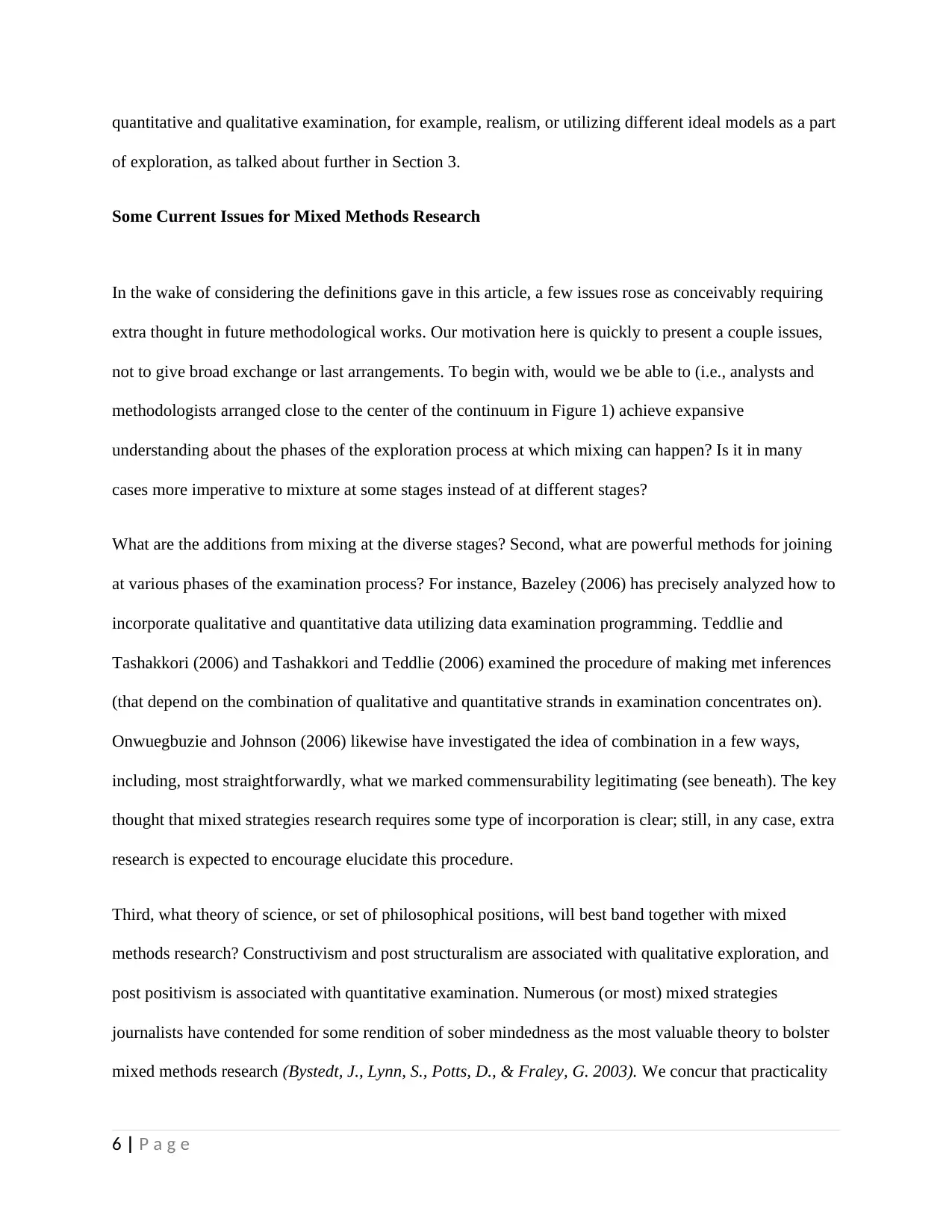
quantitative and qualitative examination, for example, realism, or utilizing different ideal models as a part
of exploration, as talked about further in Section 3.
Some Current Issues for Mixed Methods Research
In the wake of considering the definitions gave in this article, a few issues rose as conceivably requiring
extra thought in future methodological works. Our motivation here is quickly to present a couple issues,
not to give broad exchange or last arrangements. To begin with, would we be able to (i.e., analysts and
methodologists arranged close to the center of the continuum in Figure 1) achieve expansive
understanding about the phases of the exploration process at which mixing can happen? Is it in many
cases more imperative to mixture at some stages instead of at different stages?
What are the additions from mixing at the diverse stages? Second, what are powerful methods for joining
at various phases of the examination process? For instance, Bazeley (2006) has precisely analyzed how to
incorporate qualitative and quantitative data utilizing data examination programming. Teddlie and
Tashakkori (2006) and Tashakkori and Teddlie (2006) examined the procedure of making met inferences
(that depend on the combination of qualitative and quantitative strands in examination concentrates on).
Onwuegbuzie and Johnson (2006) likewise have investigated the idea of combination in a few ways,
including, most straightforwardly, what we marked commensurability legitimating (see beneath). The key
thought that mixed strategies research requires some type of incorporation is clear; still, in any case, extra
research is expected to encourage elucidate this procedure.
Third, what theory of science, or set of philosophical positions, will best band together with mixed
methods research? Constructivism and post structuralism are associated with qualitative exploration, and
post positivism is associated with quantitative examination. Numerous (or most) mixed strategies
journalists have contended for some rendition of sober mindedness as the most valuable theory to bolster
mixed methods research (Bystedt, J., Lynn, S., Potts, D., & Fraley, G. 2003). We concur that practicality
6 | P a g e
of exploration, as talked about further in Section 3.
Some Current Issues for Mixed Methods Research
In the wake of considering the definitions gave in this article, a few issues rose as conceivably requiring
extra thought in future methodological works. Our motivation here is quickly to present a couple issues,
not to give broad exchange or last arrangements. To begin with, would we be able to (i.e., analysts and
methodologists arranged close to the center of the continuum in Figure 1) achieve expansive
understanding about the phases of the exploration process at which mixing can happen? Is it in many
cases more imperative to mixture at some stages instead of at different stages?
What are the additions from mixing at the diverse stages? Second, what are powerful methods for joining
at various phases of the examination process? For instance, Bazeley (2006) has precisely analyzed how to
incorporate qualitative and quantitative data utilizing data examination programming. Teddlie and
Tashakkori (2006) and Tashakkori and Teddlie (2006) examined the procedure of making met inferences
(that depend on the combination of qualitative and quantitative strands in examination concentrates on).
Onwuegbuzie and Johnson (2006) likewise have investigated the idea of combination in a few ways,
including, most straightforwardly, what we marked commensurability legitimating (see beneath). The key
thought that mixed strategies research requires some type of incorporation is clear; still, in any case, extra
research is expected to encourage elucidate this procedure.
Third, what theory of science, or set of philosophical positions, will best band together with mixed
methods research? Constructivism and post structuralism are associated with qualitative exploration, and
post positivism is associated with quantitative examination. Numerous (or most) mixed strategies
journalists have contended for some rendition of sober mindedness as the most valuable theory to bolster
mixed methods research (Bystedt, J., Lynn, S., Potts, D., & Fraley, G. 2003). We concur that practicality
6 | P a g e
⊘ This is a preview!⊘
Do you want full access?
Subscribe today to unlock all pages.

Trusted by 1+ million students worldwide
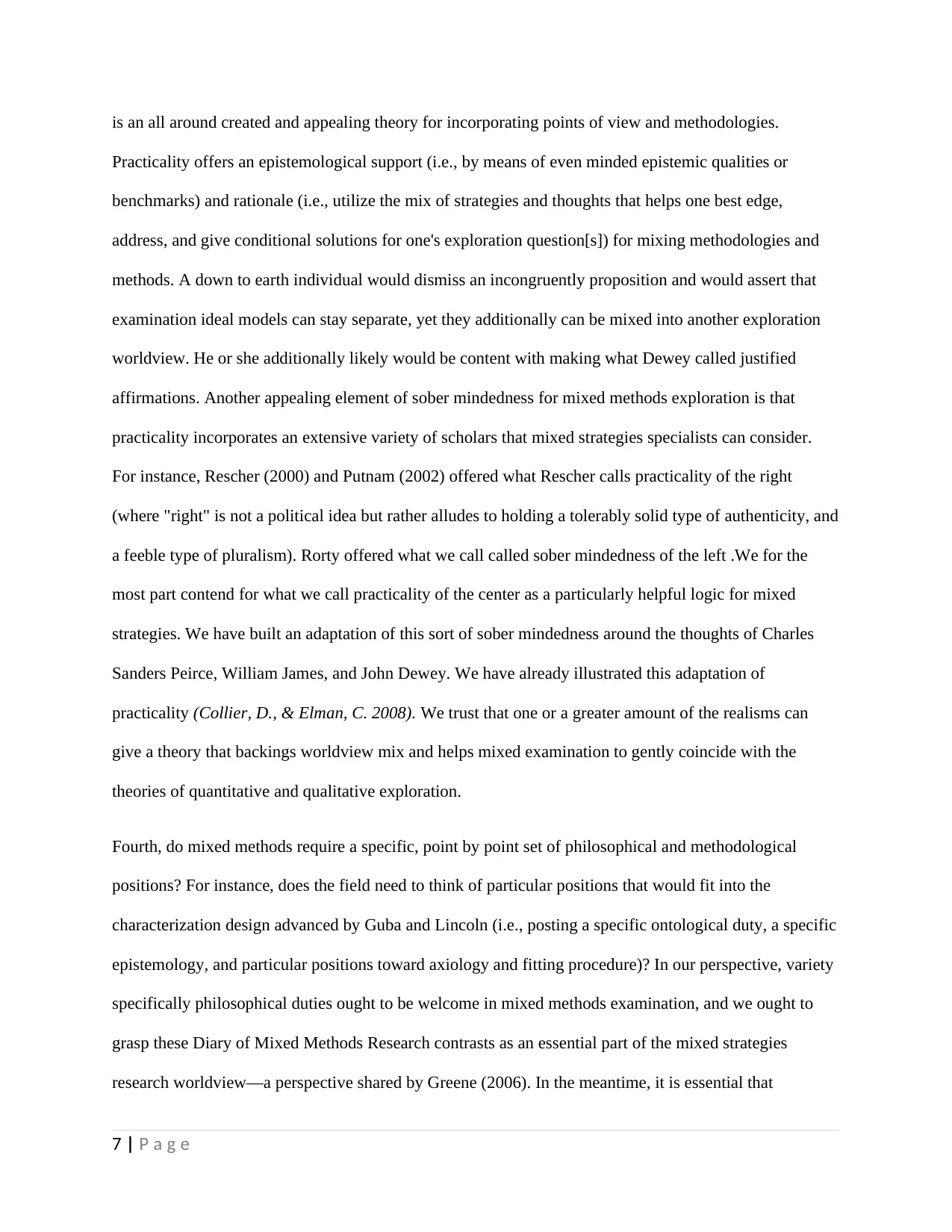
is an all around created and appealing theory for incorporating points of view and methodologies.
Practicality offers an epistemological support (i.e., by means of even minded epistemic qualities or
benchmarks) and rationale (i.e., utilize the mix of strategies and thoughts that helps one best edge,
address, and give conditional solutions for one's exploration question[s]) for mixing methodologies and
methods. A down to earth individual would dismiss an incongruently proposition and would assert that
examination ideal models can stay separate, yet they additionally can be mixed into another exploration
worldview. He or she additionally likely would be content with making what Dewey called justified
affirmations. Another appealing element of sober mindedness for mixed methods exploration is that
practicality incorporates an extensive variety of scholars that mixed strategies specialists can consider.
For instance, Rescher (2000) and Putnam (2002) offered what Rescher calls practicality of the right
(where "right" is not a political idea but rather alludes to holding a tolerably solid type of authenticity, and
a feeble type of pluralism). Rorty offered what we call called sober mindedness of the left .We for the
most part contend for what we call practicality of the center as a particularly helpful logic for mixed
strategies. We have built an adaptation of this sort of sober mindedness around the thoughts of Charles
Sanders Peirce, William James, and John Dewey. We have already illustrated this adaptation of
practicality (Collier, D., & Elman, C. 2008). We trust that one or a greater amount of the realisms can
give a theory that backings worldview mix and helps mixed examination to gently coincide with the
theories of quantitative and qualitative exploration.
Fourth, do mixed methods require a specific, point by point set of philosophical and methodological
positions? For instance, does the field need to think of particular positions that would fit into the
characterization design advanced by Guba and Lincoln (i.e., posting a specific ontological duty, a specific
epistemology, and particular positions toward axiology and fitting procedure)? In our perspective, variety
specifically philosophical duties ought to be welcome in mixed methods examination, and we ought to
grasp these Diary of Mixed Methods Research contrasts as an essential part of the mixed strategies
research worldview—a perspective shared by Greene (2006). In the meantime, it is essential that
7 | P a g e
Practicality offers an epistemological support (i.e., by means of even minded epistemic qualities or
benchmarks) and rationale (i.e., utilize the mix of strategies and thoughts that helps one best edge,
address, and give conditional solutions for one's exploration question[s]) for mixing methodologies and
methods. A down to earth individual would dismiss an incongruently proposition and would assert that
examination ideal models can stay separate, yet they additionally can be mixed into another exploration
worldview. He or she additionally likely would be content with making what Dewey called justified
affirmations. Another appealing element of sober mindedness for mixed methods exploration is that
practicality incorporates an extensive variety of scholars that mixed strategies specialists can consider.
For instance, Rescher (2000) and Putnam (2002) offered what Rescher calls practicality of the right
(where "right" is not a political idea but rather alludes to holding a tolerably solid type of authenticity, and
a feeble type of pluralism). Rorty offered what we call called sober mindedness of the left .We for the
most part contend for what we call practicality of the center as a particularly helpful logic for mixed
strategies. We have built an adaptation of this sort of sober mindedness around the thoughts of Charles
Sanders Peirce, William James, and John Dewey. We have already illustrated this adaptation of
practicality (Collier, D., & Elman, C. 2008). We trust that one or a greater amount of the realisms can
give a theory that backings worldview mix and helps mixed examination to gently coincide with the
theories of quantitative and qualitative exploration.
Fourth, do mixed methods require a specific, point by point set of philosophical and methodological
positions? For instance, does the field need to think of particular positions that would fit into the
characterization design advanced by Guba and Lincoln (i.e., posting a specific ontological duty, a specific
epistemology, and particular positions toward axiology and fitting procedure)? In our perspective, variety
specifically philosophical duties ought to be welcome in mixed methods examination, and we ought to
grasp these Diary of Mixed Methods Research contrasts as an essential part of the mixed strategies
research worldview—a perspective shared by Greene (2006). In the meantime, it is essential that
7 | P a g e
Paraphrase This Document
Need a fresh take? Get an instant paraphrase of this document with our AI Paraphraser
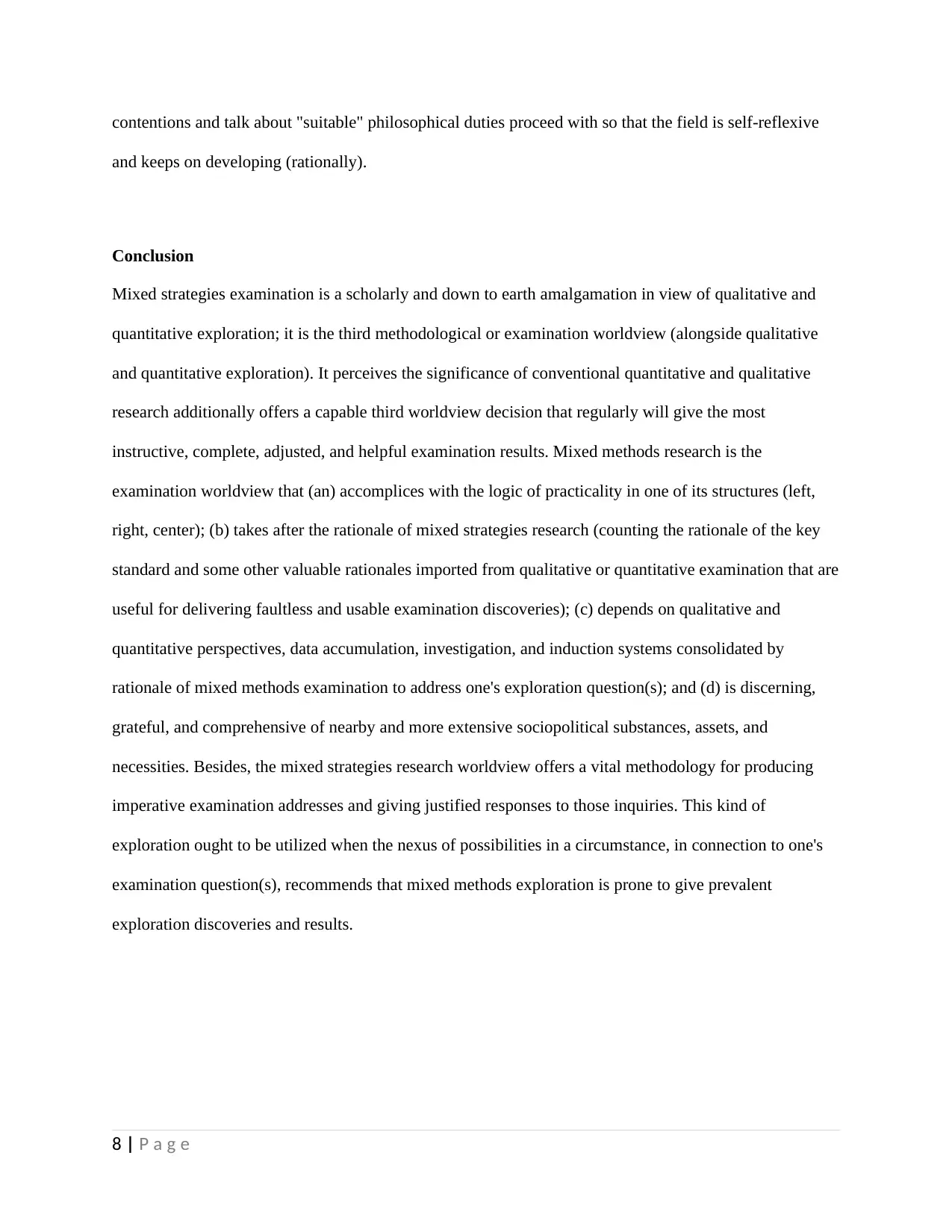
contentions and talk about "suitable" philosophical duties proceed with so that the field is self-reflexive
and keeps on developing (rationally).
Conclusion
Mixed strategies examination is a scholarly and down to earth amalgamation in view of qualitative and
quantitative exploration; it is the third methodological or examination worldview (alongside qualitative
and quantitative exploration). It perceives the significance of conventional quantitative and qualitative
research additionally offers a capable third worldview decision that regularly will give the most
instructive, complete, adjusted, and helpful examination results. Mixed methods research is the
examination worldview that (an) accomplices with the logic of practicality in one of its structures (left,
right, center); (b) takes after the rationale of mixed strategies research (counting the rationale of the key
standard and some other valuable rationales imported from qualitative or quantitative examination that are
useful for delivering faultless and usable examination discoveries); (c) depends on qualitative and
quantitative perspectives, data accumulation, investigation, and induction systems consolidated by
rationale of mixed methods examination to address one's exploration question(s); and (d) is discerning,
grateful, and comprehensive of nearby and more extensive sociopolitical substances, assets, and
necessities. Besides, the mixed strategies research worldview offers a vital methodology for producing
imperative examination addresses and giving justified responses to those inquiries. This kind of
exploration ought to be utilized when the nexus of possibilities in a circumstance, in connection to one's
examination question(s), recommends that mixed methods exploration is prone to give prevalent
exploration discoveries and results.
8 | P a g e
and keeps on developing (rationally).
Conclusion
Mixed strategies examination is a scholarly and down to earth amalgamation in view of qualitative and
quantitative exploration; it is the third methodological or examination worldview (alongside qualitative
and quantitative exploration). It perceives the significance of conventional quantitative and qualitative
research additionally offers a capable third worldview decision that regularly will give the most
instructive, complete, adjusted, and helpful examination results. Mixed methods research is the
examination worldview that (an) accomplices with the logic of practicality in one of its structures (left,
right, center); (b) takes after the rationale of mixed strategies research (counting the rationale of the key
standard and some other valuable rationales imported from qualitative or quantitative examination that are
useful for delivering faultless and usable examination discoveries); (c) depends on qualitative and
quantitative perspectives, data accumulation, investigation, and induction systems consolidated by
rationale of mixed methods examination to address one's exploration question(s); and (d) is discerning,
grateful, and comprehensive of nearby and more extensive sociopolitical substances, assets, and
necessities. Besides, the mixed strategies research worldview offers a vital methodology for producing
imperative examination addresses and giving justified responses to those inquiries. This kind of
exploration ought to be utilized when the nexus of possibilities in a circumstance, in connection to one's
examination question(s), recommends that mixed methods exploration is prone to give prevalent
exploration discoveries and results.
8 | P a g e
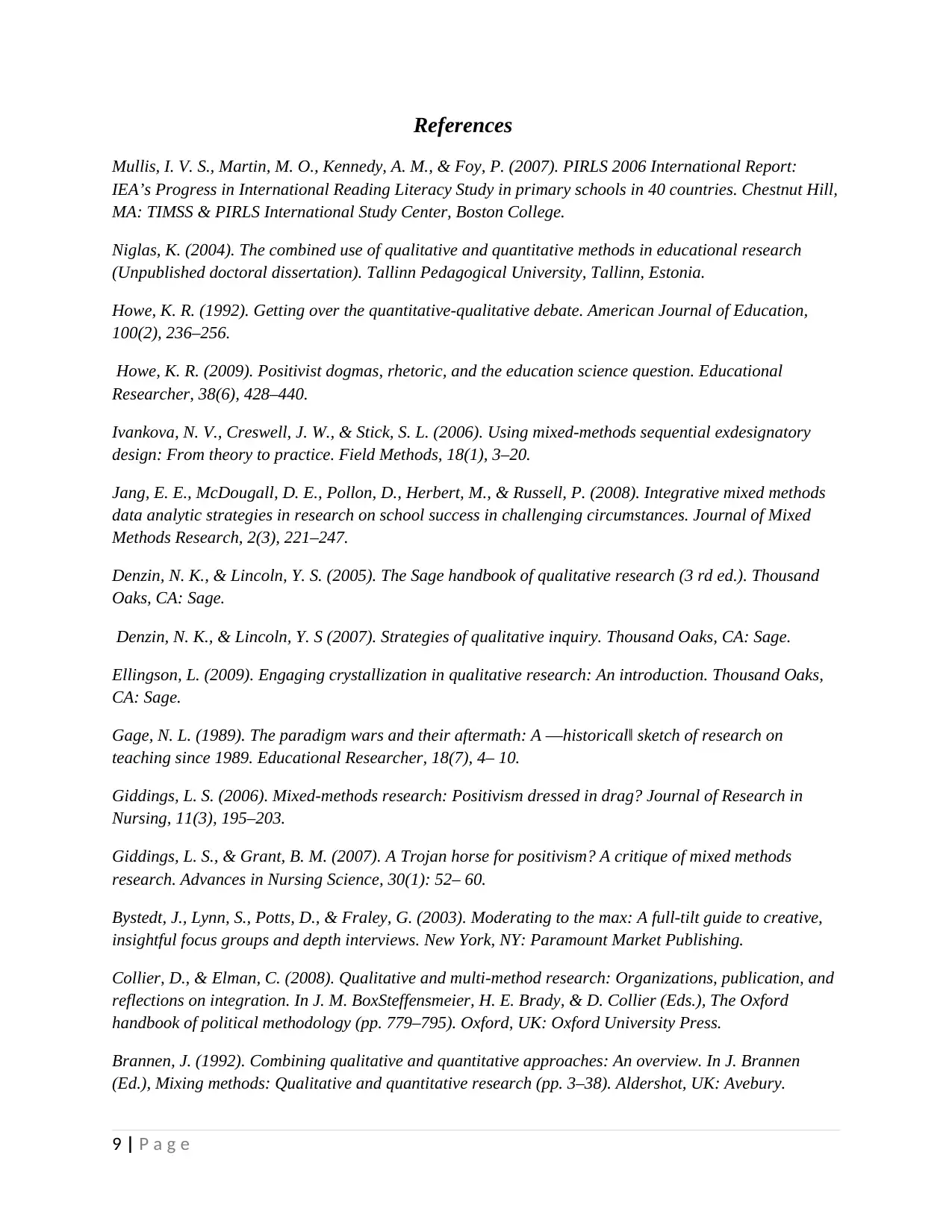
References
Mullis, I. V. S., Martin, M. O., Kennedy, A. M., & Foy, P. (2007). PIRLS 2006 International Report:
IEA’s Progress in International Reading Literacy Study in primary schools in 40 countries. Chestnut Hill,
MA: TIMSS & PIRLS International Study Center, Boston College.
Niglas, K. (2004). The combined use of qualitative and quantitative methods in educational research
(Unpublished doctoral dissertation). Tallinn Pedagogical University, Tallinn, Estonia.
Howe, K. R. (1992). Getting over the quantitative-qualitative debate. American Journal of Education,
100(2), 236–256.
Howe, K. R. (2009). Positivist dogmas, rhetoric, and the education science question. Educational
Researcher, 38(6), 428–440.
Ivankova, N. V., Creswell, J. W., & Stick, S. L. (2006). Using mixed-methods sequential exdesignatory
design: From theory to practice. Field Methods, 18(1), 3–20.
Jang, E. E., McDougall, D. E., Pollon, D., Herbert, M., & Russell, P. (2008). Integrative mixed methods
data analytic strategies in research on school success in challenging circumstances. Journal of Mixed
Methods Research, 2(3), 221–247.
Denzin, N. K., & Lincoln, Y. S. (2005). The Sage handbook of qualitative research (3 rd ed.). Thousand
Oaks, CA: Sage.
Denzin, N. K., & Lincoln, Y. S (2007). Strategies of qualitative inquiry. Thousand Oaks, CA: Sage.
Ellingson, L. (2009). Engaging crystallization in qualitative research: An introduction. Thousand Oaks,
CA: Sage.
Gage, N. L. (1989). The paradigm wars and their aftermath: A ―historical‖ sketch of research on
teaching since 1989. Educational Researcher, 18(7), 4– 10.
Giddings, L. S. (2006). Mixed-methods research: Positivism dressed in drag? Journal of Research in
Nursing, 11(3), 195–203.
Giddings, L. S., & Grant, B. M. (2007). A Trojan horse for positivism? A critique of mixed methods
research. Advances in Nursing Science, 30(1): 52– 60.
Bystedt, J., Lynn, S., Potts, D., & Fraley, G. (2003). Moderating to the max: A full-tilt guide to creative,
insightful focus groups and depth interviews. New York, NY: Paramount Market Publishing.
Collier, D., & Elman, C. (2008). Qualitative and multi-method research: Organizations, publication, and
reflections on integration. In J. M. BoxSteffensmeier, H. E. Brady, & D. Collier (Eds.), The Oxford
handbook of political methodology (pp. 779–795). Oxford, UK: Oxford University Press.
Brannen, J. (1992). Combining qualitative and quantitative approaches: An overview. In J. Brannen
(Ed.), Mixing methods: Qualitative and quantitative research (pp. 3–38). Aldershot, UK: Avebury.
9 | P a g e
Mullis, I. V. S., Martin, M. O., Kennedy, A. M., & Foy, P. (2007). PIRLS 2006 International Report:
IEA’s Progress in International Reading Literacy Study in primary schools in 40 countries. Chestnut Hill,
MA: TIMSS & PIRLS International Study Center, Boston College.
Niglas, K. (2004). The combined use of qualitative and quantitative methods in educational research
(Unpublished doctoral dissertation). Tallinn Pedagogical University, Tallinn, Estonia.
Howe, K. R. (1992). Getting over the quantitative-qualitative debate. American Journal of Education,
100(2), 236–256.
Howe, K. R. (2009). Positivist dogmas, rhetoric, and the education science question. Educational
Researcher, 38(6), 428–440.
Ivankova, N. V., Creswell, J. W., & Stick, S. L. (2006). Using mixed-methods sequential exdesignatory
design: From theory to practice. Field Methods, 18(1), 3–20.
Jang, E. E., McDougall, D. E., Pollon, D., Herbert, M., & Russell, P. (2008). Integrative mixed methods
data analytic strategies in research on school success in challenging circumstances. Journal of Mixed
Methods Research, 2(3), 221–247.
Denzin, N. K., & Lincoln, Y. S. (2005). The Sage handbook of qualitative research (3 rd ed.). Thousand
Oaks, CA: Sage.
Denzin, N. K., & Lincoln, Y. S (2007). Strategies of qualitative inquiry. Thousand Oaks, CA: Sage.
Ellingson, L. (2009). Engaging crystallization in qualitative research: An introduction. Thousand Oaks,
CA: Sage.
Gage, N. L. (1989). The paradigm wars and their aftermath: A ―historical‖ sketch of research on
teaching since 1989. Educational Researcher, 18(7), 4– 10.
Giddings, L. S. (2006). Mixed-methods research: Positivism dressed in drag? Journal of Research in
Nursing, 11(3), 195–203.
Giddings, L. S., & Grant, B. M. (2007). A Trojan horse for positivism? A critique of mixed methods
research. Advances in Nursing Science, 30(1): 52– 60.
Bystedt, J., Lynn, S., Potts, D., & Fraley, G. (2003). Moderating to the max: A full-tilt guide to creative,
insightful focus groups and depth interviews. New York, NY: Paramount Market Publishing.
Collier, D., & Elman, C. (2008). Qualitative and multi-method research: Organizations, publication, and
reflections on integration. In J. M. BoxSteffensmeier, H. E. Brady, & D. Collier (Eds.), The Oxford
handbook of political methodology (pp. 779–795). Oxford, UK: Oxford University Press.
Brannen, J. (1992). Combining qualitative and quantitative approaches: An overview. In J. Brannen
(Ed.), Mixing methods: Qualitative and quantitative research (pp. 3–38). Aldershot, UK: Avebury.
9 | P a g e
⊘ This is a preview!⊘
Do you want full access?
Subscribe today to unlock all pages.

Trusted by 1+ million students worldwide
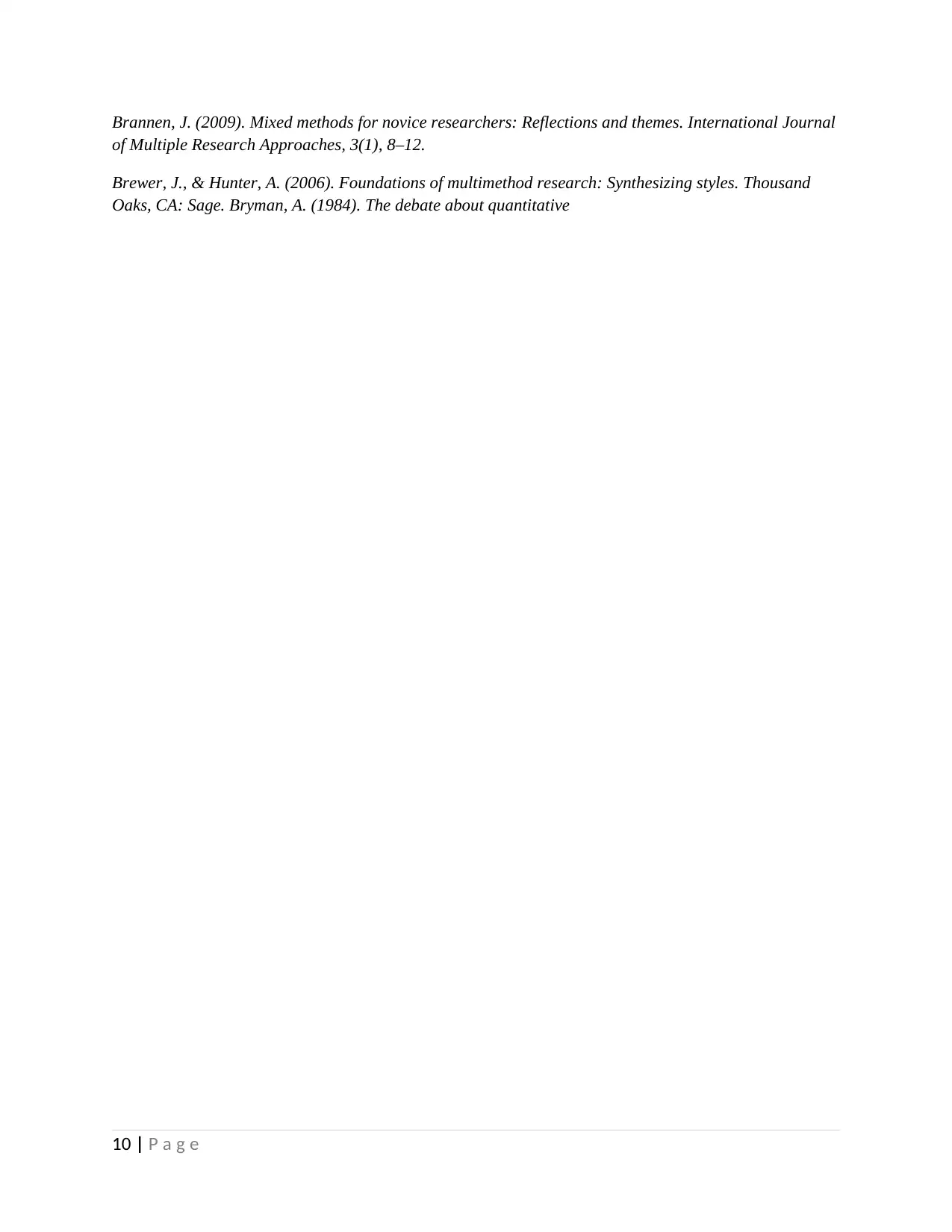
Brannen, J. (2009). Mixed methods for novice researchers: Reflections and themes. International Journal
of Multiple Research Approaches, 3(1), 8–12.
Brewer, J., & Hunter, A. (2006). Foundations of multimethod research: Synthesizing styles. Thousand
Oaks, CA: Sage. Bryman, A. (1984). The debate about quantitative
10 | P a g e
of Multiple Research Approaches, 3(1), 8–12.
Brewer, J., & Hunter, A. (2006). Foundations of multimethod research: Synthesizing styles. Thousand
Oaks, CA: Sage. Bryman, A. (1984). The debate about quantitative
10 | P a g e
1 out of 10
Related Documents
Your All-in-One AI-Powered Toolkit for Academic Success.
+13062052269
info@desklib.com
Available 24*7 on WhatsApp / Email
![[object Object]](/_next/static/media/star-bottom.7253800d.svg)
Unlock your academic potential
Copyright © 2020–2025 A2Z Services. All Rights Reserved. Developed and managed by ZUCOL.





